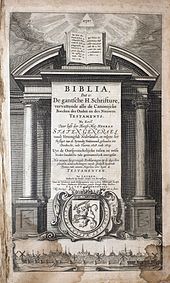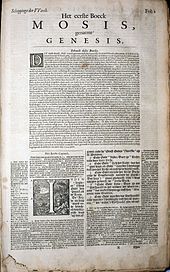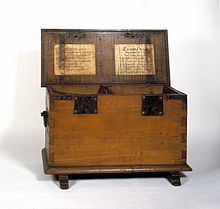State translation


The States translation or States Bible , Dutch Statenvertaling or Statenbijbel , is the most historically significant Bible translation in Dutch . The translation work was decided by the Reformed Dordrecht Synod in 1619, financed by the States General - hence the naturalized name - and completed by selected Reformed theologians from different regions of the Dutch-speaking area in joint work by 1637. The state translation with its explanations and cross-references shaped the reception of the Bible in the Protestant Dutch for centuries and had a great influence on the development of the standard Nine-Dutch language .
Synodal resolution
Several Dutch translations of the Bible had already been made in the 16th century. The most common was the Deuxaesbijbel ( Emden 1562). What they all had in common, however, was a typical regional language form. Some were also strongly oriented towards the Vulgate , others towards the Luther Bible .
The all -Dutch Synod of Dordrecht met in 1618 during the armistice years in the Spanish-Dutch War . The occasion was the dispute between strict predestinians and remonstrants about divine predestination. In addition, other questions of faith and church organization were discussed.
A new translation of the Bible was agreed unanimously. This should
- reproduce the original Hebrew or Greek text as literally as possible and, where this is not possible in legible Dutch, provide a verbatim reproduction in the margin;
- wherever additional words are indispensable in the biblical text to illuminate the meaning, put them in brackets and with different letters ;
- provide a table of contents before each book and each chapter and indicate biblical passages with the same statement in the margin;
- contain a reason for the selected translation for unclear text passages, but without dogmatic discussions.
The Old Testament name of God YHWH should be rendered with ARMY ("Lord" in capitals ).
The Old Testament Apocrypha , i.e. those late Old Testament writings contained in the Septuagint and Vulgate , which are not handed down in Hebrew and were not considered canonical by the Reformers , should only be added as an appendix in smaller letters and with their own page numbering.
In terms of language, the translation should be national as possible and understandable for all Dutch people. The individual question of whether the old pronoun du or the - actually plural - pronoun gij should be used for the second person singular , which had established itself in almost all dialects in everyday language, was discussed intensively . The synod finally decided in favor of gij .
Translation work
The synod commissioned the translation work
- for the Old Testament Johann Bogermann , Wilhelm Baudaert and Gerson Bucerus ;
- for the New Testament and the Apocrypha Jacob Roland , Hermann Faukel and Petrus Cornelisz .
However, Faukel and Cornelisz died before work began. Festus Hommius and Antonius Walaeus took their place .
Bogermann came from Upleward (East Friesland), Baudaert from Deinze (East Flanders), Bucerus was a preacher in Veere (Zeeland), Roland came from Delft (South Holland), Hommius from Jelsum (Friesland) and Walaeus from Gent (East Flanders). The Synod also appointed revisers from most of the provinces in the language area to proofread the translation and, where necessary, propose changes.
The lengthy translation work could not begin until 1626. At the request of the Synod, the States General took over the official authorization and funding. The translators took up residence in the university city of Leiden in order to be able to use the library and the linguistic experts on site. On September 17, 1637, the first printed copy was handed over to the States General.
In 1662 an oak chest with two locks for the original manuscripts and the proof sheets of the state translation was made at state expense. It was kept in the Leiden City Hall. Every three years the content was examined by representatives of the States General and the Reformed Church, a solemn act framed by supplications and thanksgiving. The chest is now in the Utrecht Museum Catharijneconvent , the contents in Het Utrecht Archief .
Impact history
The introduction of the new Bible did not succeed in all parts of the country without delay and resistance. Quite a few communities encountered unusual syntax influenced by the original languages, archaisms and neologisms, and expressions that were not used in their own dialect or had a different meaning. Particularly in the north, the southern language peculiarities were rejected as early as the 17th century. But the state authority was stronger than the resistance. The Statenbijbel became the mandatory school Bible and was available in almost every house in the course of a few years. It became common practice to read from it every day after the meal together. The alien and the ancient were perceived as a sign of sacredness. The state translation functioned as a supra-regional model for an upscale linguistic style until the 20th century.
Web links
- statenvertaling.net (Dutch)
- The "State Bible" - the translation of the Bible from 1637 ( FU Berlin , Dutch Studies)
Individual evidence
- ↑ statenvertaling.net
- ↑ Dutch original text of the four translation principles
- ↑ The reverse was done with the English King James Bible of 1611, so that the English church language used thou and thine as the address to God well into the 20th century .
- ↑ catharijneconvent.nl
